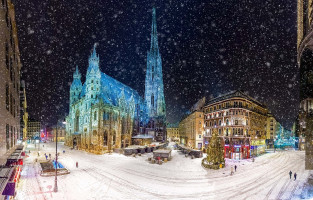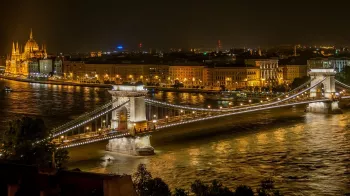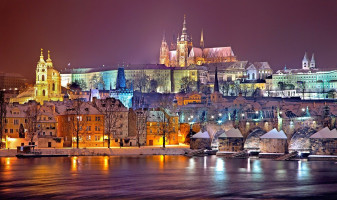Prague Castle
Duration
2 to 4 Days
2 to 4 Days
Best time to visit
May-Jun, Sep
May-Jun, Sep
Theme
Heritage
Heritage
Prague Castle Travel Guide
Prague Castle, located in the capital city of the Czech Republic, is a historic fortress that dates back to the 9th century. It is the largest ancient castle in the world, covering over 7 hectares, and it has been the seat of Czech kings, emperors, and presidents. The castle complex includes a variety of architectural styles, from Romanesque to Gothic, Renaissance, and Baroque, making it a significant symbol of the country's history and culture.Top Attractions in Prague Castle
- St. Vitus Cathedral
- Old Royal Palace
- Golden Lane
- St. George's Basilica
- Prague Castle Gardens
Prague Castle is Famous for
Its stunning architecture, rich history, and panoramic views of the city.Top Attractions in Prague Castle
- Exploring the historic St. Vitus Cathedral
- Visiting the charming Golden Lane
- Admiring the intricate details of St. George's Basilica
- Strolling through the picturesque Prague Castle Gardens
What's Great about Travelling to Prague Castle?
- Rich history and cultural significance
- Breathtaking views of Prague
- Unique architectural styles to admire
What's Not So Great about Travelling to Prague Castle?
- Crowded with tourists during peak seasons
- Hilly terrain may be challenging for some visitors
- Limited dining options within the castle complex
Travel Tips for Prague Castle
- Check the official website for updated visiting hours and ticket prices
- Wear comfortable shoes for exploring the castle grounds
- Be mindful of your belongings in crowded areas
Important Prague Castle trip information
- Ideal Duration: 1-2 days to explore the entire castle complex
- Best Time to Visit: Spring or fall for pleasant weather and fewer crowds
- Nearby Airports and Railway Stations: Prague Vaclav Havel Airport and Prague Main Railway Station
Per Person
90,000
*EXCLUDING APPLICABLE TAXES 5.0 Ratings
( 4 Reviews )
( 4 Reviews )
Total
5,04,000
*EXCLUDING APPLICABLE TAXES 5.0 Ratings
( 20 Reviews )
( 20 Reviews )
Total
4,16,000
*EXCLUDING APPLICABLE TAXES 5.0 Ratings
( 20 Reviews )
( 20 Reviews )
Total
4,76,500
*EXCLUDING APPLICABLE TAXES 5.0 Ratings
( 20 Reviews )
( 20 Reviews )
Per Person
60,000
*EXCLUDING APPLICABLE TAXES 4.9 Ratings
( 200 Reviews )
( 200 Reviews )
Total
3,22,500
*EXCLUDING APPLICABLE TAXES 5.0 Ratings
( 20 Reviews )
( 20 Reviews )
FAQ's on Prague Castle
Q1: What is the best time to visit Prague Castle?
The best time to visit Prague Castle is during the spring (April to June) and fall (September to October) when the weather is mild, and crowds are not as intense as in the peak summer months. Additionally, visiting early in the morning or later in the afternoon can help avoid the busiest times. Special events like concerts or historical reenactments may also influence your timing.
Q2: Do I need a visa to travel to Prague Castle?
Prague Castle is located in the Czech Republic, which is a part of the Schengen Area. Most visitors from the EU, the U.S., Canada, Australia, and many other countries can enter the Czech Republic visa-free for stays of up to 90 days. However, it's essential to check the specific visa requirements based on your nationality before traveling.
Q3: What are the must-visit attractions in Prague Castle?
Prague Castle is a vast complex with numerous attractions, including St. Vitus Cathedral, Old Royal Palace, Golden Lane, and the picturesque gardens. Don't miss the Changing of the Guard ceremony, which takes place every hour. The views from the castle overlooking the city are breathtaking. Exploring the charming streets of Lesser Town (Mala Strana) nearby is also highly recommended.
Q4: Is Prague Castle a safe place to travel?
Prague Castle is generally safe for visitors. However, like any tourist destination, it's essential to be cautious of pickpocketing in crowded areas. Avoid poorly lit or deserted alleys at night, and be aware of your surroundings. The castle complex itself is well-monitored by security. It's advisable to stay on designated paths and respect any posted rules or restrictions.
Q5: What is the local currency in Prague Castle and can I use credit cards?
The local currency in Prague Castle, as well as the entire Czech Republic, is the Czech Koruna (CZK). While credit cards are widely accepted in hotels, restaurants, and larger stores, it's recommended to carry some cash for smaller establishments and local vendors. ATMs are easily found in the city for currency exchange.
Q6: What is the local cuisine like in Prague Castle?
Czech cuisine is hearty and flavorful, featuring dishes like goulash, roast pork with dumplings, and traditional pastries like trdelnik. Don't miss trying Czech beer, which is renowned worldwide. Vegetarians will find options like fried cheese (smazeny syr) or potato pancakes (bramboraky). Be sure to taste local desserts like palacinky (pancakes) and kolace (sweet pastries). Dining in cozy taverns or beer halls within the castle area can enhance your culinary experience.
Q7: What transportation options are available in Prague Castle?
Prague Castle is easily accessible by public transport, including trams, buses, and the metro. Tram 22 takes you directly to the castle entrance. Taxis are also available, but it's advisable to use reputable companies or apps for fair pricing. Walking is a popular option, allowing you to explore the charming streets leading up to the castle. For those who prefer flexibility, car rentals are available, but parking near the castle can be limited.
Q8: Are there any cultural norms or etiquette I should be aware of when visiting Prague Castle?
When visiting Prague Castle, it's important to dress modestly, especially when entering religious sites like St. Vitus Cathedral. Respect local customs by greeting people with a polite "dobry den" (good day) and using "prosim" (please) and "dekuji" (thank you). Keep in mind that public displays of affection should be kept to a minimum. When dining, wait for everyone at the table to be served before starting your meal. Tipping around 10% is appreciated in restaurants. Remember to stand on the right side on escalators and give way to those exiting public transport.
Q9: I am a travel agent. How can I buy travel leads of Prague Castle?
Register yourself as a travel agent at agents.tripclap.com and then you can buy travel leads to Prague Castle once your account is approved. For more details contact our support team at +91-8069186564 or support@tripclap.com



